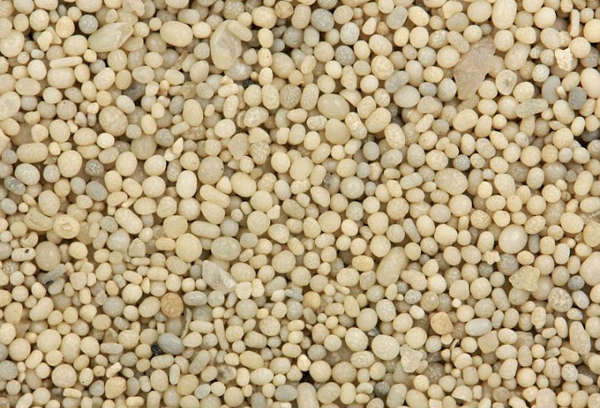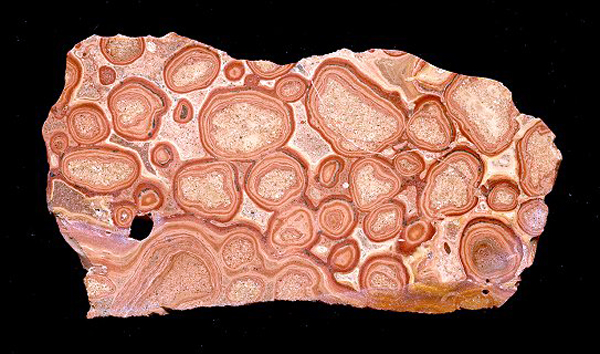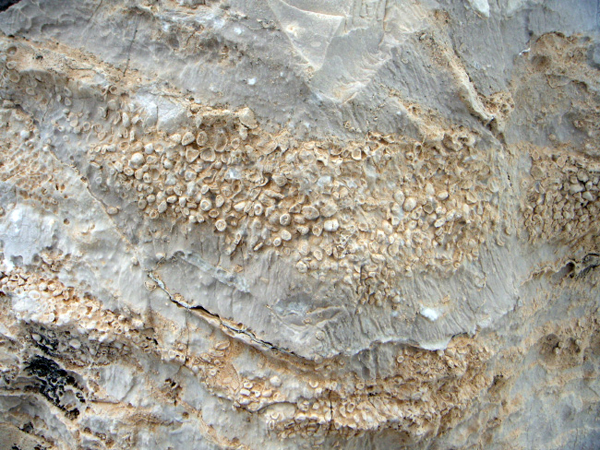Allochem
An allochem is a term used to describe a grain larger than 0.25 mm within a carbonate rock. The abundance and type of allochems within a carbonate rock are used to classify the specimen. Allochems include ooliths, peloids, intra and extraclasts, pisoliths, oncoliths and bioclasts.Ooliths or ooids are spherical or ellipsoidal grains, less than 2mm in diameter, having concentric laminae around a nucleus. Ooliths are usually composed of calcite, but can include hematite, chert, phosphates and dolomite. Ancient ooliths can also exhibit radial arrangements of calcite crystals around nuclei perhaps due to inversion of aragonite to calcite. The concentric portions of ooliths are known as the cortex. Ooliths with thin cortices around large cores are known as superficial ooliths. Ooliths are thought to form by the accretion of small grains on the surface of the nucleus as it rolls in a current. The fine-carbonate mud accreted to the oolith usually forms by precipitation. They are typical of shallow water, usually subtidal or lower intratidal environments.

Ooliths, Bahamas
oncolith also known as a oncoid, is a concentric sedimentary grain, >2 mm in diameter, formed by blue-algae binding concentric shells of micrite. Oncoliths can be difficult to distinguish from pisoliths but typically have asymmetric, wavy layers.

oncolith, Sahara Desert

oncolith, Sahara Desert
A peloid is a spherical to ellisoidal particle consisting of micrite (lime mud) smaller than 2 mm with no recognisable concentric or radial structure. Small smooth peloids are interpreted as carbonate fecal pellets produced by organisms that consume carbonate mud. The pellet is the excreted, undigested matter and frequently contains organics and so it dark in colour. Pellets usually have a restricted size range. Larger, irregular peloids may be the result of micritization of other allochems. Carbonate rocks containing high abundances of pellets are often termed peloidal and indicate low energy deposition (e.g. lagoonal). Disaggregation of peloids will lead to carbonate mud (micrite).
An intraclast is a clast within a carbonate rock formed by fragmentation, transport and deposition of a semilithified carbonate sediment. The term lithoclast implies the carbonate sediment comprising the clast was deposited broadly contemporaneously with the sediment in which it is found. An intraclast is a form of lithoclast in a limestone that is distinct from an extraclast, defined as a clast derived from an ancient limestone. Intraclasts form by fragmentation of rapidly cemented sediments in a high energy environment/event such as a tidal zone, or due to storm events. They are transported to the site of deposition by currents
A pisolith also known as a pisoid, is a concentric sedimentary grain, >2 mm in diameter, formed as a concretion. Pisoliths are often found in carbonate rocks, but are also common in bauxites, limonites and siderites. It is often difficult to distinguish pisoliths from oncoliths, however, pisoliths tend to have symmetric, smooth layering. Rocks dominated by pisoliths can be termed pisolites and represent soil layers forming due to long exposure on the land surface. In carbonates pisoliths often are found in supratidal environments.
A bioclast is a grain (allochem) within a carbonate rock derived from the remains of the hard parts of carbonate secreting organisms. Common bioclasts are derived from molluscs, bryozoans, corals, echinoids, crinoids and forminafera. Bioclasts may be whole of fragmental parts of skeletal material. The nature of bioclasts differs with the type of organism and diagenesis. Articulate brachipods, echnoids and crinoids all are comprised of calcite that often preserves internal shell structure. Brachipods tend to have a two layer structure with an inner foliated layer and an outer prismatic layer of calcite. Echinoid and crinoid parts, such as ossicles form from single crystals of calcite often with numerous small pores. Echinoid spines are circular to elliptical and exhibit a range of radial structures.
Bibliography
• M. J. Hibbard (1994): Petrography to Petrogenesis. Prentice Hall editore
• E. WM. Heinrich (1956): Microscopic Petrografy. Mcgraw-hill book company,inc

